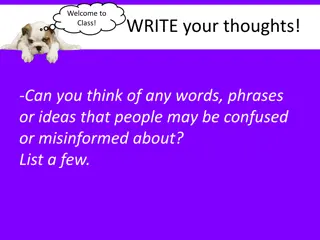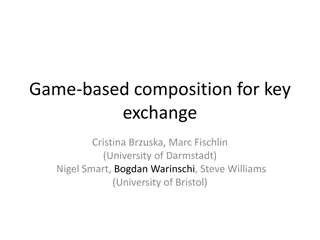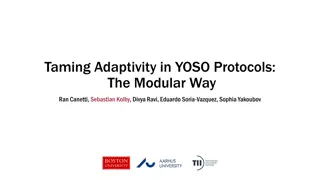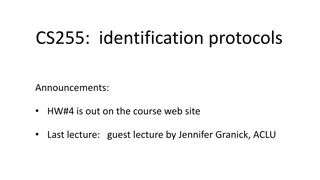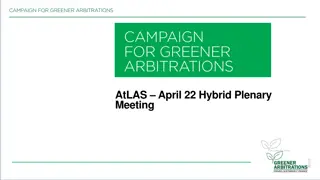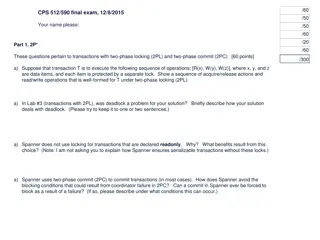Animal Use Protocols: Finding the Right Balance
Exploring the analogy between the story of the three bears and animal use protocols, this content delves into the importance of providing just the right amount of information in research protocols. Through examples of intravenous injections in mice, the text emphasizes the necessity of striking the perfect balance between too much specificity and too little vagueness in experimental procedures. It offers detailed insights into anesthetic methods, drug administration, and post-injection observations to ensure the well-being of research animals while conducting experiments.
Download Presentation

Please find below an Image/Link to download the presentation.
The content on the website is provided AS IS for your information and personal use only. It may not be sold, licensed, or shared on other websites without obtaining consent from the author.If you encounter any issues during the download, it is possible that the publisher has removed the file from their server.
You are allowed to download the files provided on this website for personal or commercial use, subject to the condition that they are used lawfully. All files are the property of their respective owners.
The content on the website is provided AS IS for your information and personal use only. It may not be sold, licensed, or shared on other websites without obtaining consent from the author.
E N D
Presentation Transcript
Microsoft clipart, the three bears - Bing images Getting it just right Joan T Richerson, MS, DVM, MS, DACLAM Assistant Chief Veterinary Medical Officer 10/19/21 AALAS National Meeting Kansas City, MO
Getting it just right How is the children s story of the three bears like an animal use protocol? Porridge Animal Use Protocol Too much and too specific information Too little and too vague information Just the right amount of information Microsoft clipart, the three bears and their porridge - Bing images
Getting it just right Example 1: Intravenous injection Mice will be anesthetized. The tail is secured; a needle and syringe are used to inject the experimental drug. Once the mice are awake, they are returned to their home cages.
Getting it just right Example 2: Intravenous injection Mice will be anesthetized with isoflurane (2-5%)via nose cone inhalation with a rodent anesthesia machine. Alternatively, injectable ketamine or ketamine in combination with other injectable anesthetics maybe used (see: Appendix 3). Once the mouse ceases movement, assessment of the toe pinch reflex and respiratory rate/depth will ensure adequate anesthesia. The tail will be cleaned using a disinfectant solution (e.g., isopropyl alcohol, betadine, or chlorhexidine). The tail is restrained while occluding one of the two lateral tail veins by applying gentle pressure. A 26-30 G needle will be inserted into the tail vein and the correct location confirmed by a flash of blood in the hub when negative pressure is applied to the syringe. The vein is released, and the experimental drug B139 is injected (see Appendix 3 for dose range). The needle is withdrawn, and gentle pressure is applied until the bleeding has stopped. Mice will be observed to ensure adequate hemostasis, and until the mice are ambulatory.
Getting it just right Example 3: Intravenous injection Mice will be anesthetized with 3% isoflurane via nose cone inhalation with a SomnoSuite Low-Flow anesthesia machine. Once the mouse ceases movement, assessment of the toe pinch reflex and respiratory rate/depth will ensure adequate anesthesia. The tail will be cleaned using 70% isopropyl alcohol applied with a cotton-tipped applicator. The tail will then be restrained with the ring-finger of the hand holding the mouse; the left lateral tail vein will be occluded by applying gentle pressure. A 1ml syringe with a 27G X1/2 needle will be inserted into the left lateral tail vein and the correct location confirmed by a flash of blood in the hub when negative pressure is applied to the syringe. The vein is then released, and 10 mg/kg of the experimental drug B139 is injected into the vein. The needle is withdrawn, and gentle pressure is applied for 5 minutes using a 2 X2 sterile gauze. Thereafter, mice will be observed every 5 minutes for 20 minutes to ensure recovery from anesthesia.
Getting it just right Example 3: Intravenous injection What s the problem? Mice will be anesthetized with 3% isoflurane via nose cone inhalation with a SomnoSuite Low-Flow anesthesia machine. Once the mouse ceases movement, assessment of the toe pinch reflex and respiratory rate/depth will ensure adequate anesthesia. The tail will be cleaned using 70% isopropyl alcohol applied with a cotton- tipped applicator. The tail will then be restrained with the ring-finger of the hand holding the mice; the left lateral tail vein will be occluded by applying gentle pressure. A 1ml syringe with a 27G X1/2 needle will be inserted into the left lateral tail vein and the correct location confirmed by a flash of blood in the hub when negative pressure is applied to the syringe. The vein is then released, and 10 mg/kg of the experimental drug B139 is injected into the vein. The needle is withdrawn, and gentle pressure is applied for 5 minutes using a 2 X2 sterile gauze. Thereafter, mice will be observed every 5 minutes for 20 minutes to ensure recovery from anesthesia.
Getting it just right Being too specific sets an IACUC up for self-made compliance problems, which could have reporting requirements. Don t paint yourself into a corner! Being too vague is also not good but has less risk of self-made compliance problems but potentially at the expense of humane care and use. Being descriptive without being too restrictive provides flexibility with adequate detail to assure humane animal care and use.
Getting it just right thank you for your kind attention! porridge-illustration-id543212456 (1024 869) (istockphoto.com)







